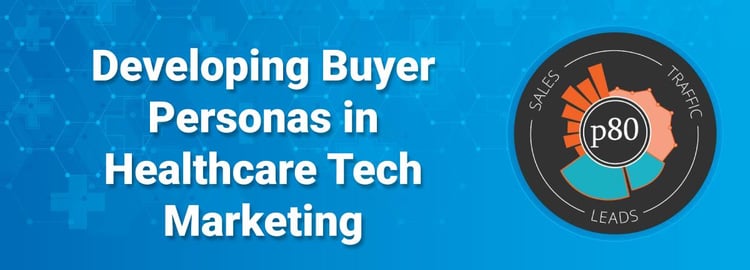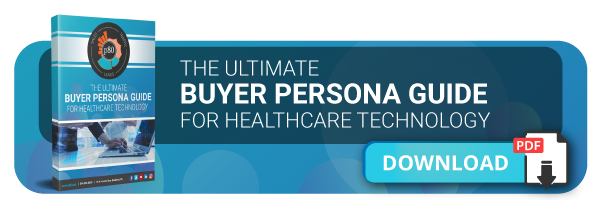Inbound Marketing Blog
for Manufacturers and Healthcare Companies
How to Develop Healthcare Technology Buyer Personas for B2B Marketing

How well do you know the prospect you’re hoping to make your next satisfied customer?
Do you know much about their day to day at work? What are the pain points of working in their industry? Or what about the resources they turn to?
For healthcare technology marketing, having a complete understanding of the ideal prospect is essential to developing a solid strategy.
It’s simply not enough to provide a generic description of who you want to sell to. Saying you want to market to a specific age range or interest group is too broad -- In today’s markets, prospects are looking for personalized experiences. Essentially, prospects want to know they matter as individuals to your company.
That’s where buyer personas come in.
What Is a Healthcare Buyer Persona?
A buyer persona is a semi-fictitious profile of your ideal customer. The best way to create a buyer persona is with market research, real data about existing customers, and a smattering of educated guesses.
So, what to include in a buyer persona?
- Demographics
- Motivations
- Goals
- Behaviors
- Pain points
Buyer personas should not be confused with target markets, which represent a particular market segment that a strategy focuses on. Buyer personas are much more specific.
p80 Tip: Some marketers take it a step further and name this customer and assign him or her a picture. It does actually help to put a name and face to the ideal customer you’ve envisioned.
 Why Healthcare Buyer Personas Matter
Why Healthcare Buyer Personas Matter
A buyer persona lets you zero-in on exactly who your ideal customer is and gives you a well-rounded understanding of this person. Buyer personas also let you get inside your ideal customer’s head.
A B2B inbound marketing strategy without a buyer persona is like starting a road trip without having even looked at a map first. While you know where you want to end up and have a general idea of what direction to travel, you have no idea of how to actually get there.
Every prospect your company deals with is somewhere on their B2B buyer’s journey, whether they’re just poking around the internet for information to solve a problem or ready to make a purchasing decision.
With a buyer persona clearly defining who your ideal customer is, the issues they’re trying to resolve, and some of the things that make them tick, you can craft content that meets their needs at every stage of their buyer’s journey.
Put simply, a buyer persona is the foundation of B2B inbound marketing tactics. Every part of a B2B content marketing strategy -- from conducting further research to developing tactics -- centers around engaging your ideal customer and nurturing them from a prospect to a satisfied customer.
Resource: 12 Statistics That Prove the Value of Creating Buyer Personas
How to Develop a Buyer Persona: Hunting for Intel
The cornerstone of a solid buyer persona is research. Without it, determining who your ideal customer is will be based strictly on conjecture and speculation.
A SaaS buyer persona and journey will probably be different from a medical device customer persona and journey. This is just one high-level example -- there are many nuances to your persona you'll need to explore.
To gather the information you should consider:
Conducting Buyer Interviews
Buyer interviews are a great tool to get first-hand knowledge from real people. A general rule of thumb is to conduct between 3-5 interviews to start with. Two potential sources for interviews are:
Existing customers: Your happy customers were once prospects. Talking to them about why they selected your company’s product or service gives you insight into exactly what worked for them with your marketing strategy. This is particularly valuable if those you interview share qualities with the type of customer you’d like to see more of.

Prospects: Prospects are interfacing with your company and its content right now. They can tell you what they need from your company in real time as they are working their way through the buyer’s journey.
p80 tip: Interviews shouldn’t be just a question and answer session, rather a dialogue. Coming prepared to an interview with follow-up questions allows for an actual conversation to happen. The easiest follow-up question: Why?
Bonus p80 tip: There’s nothing worse when conducting an interview than having to start and stop to take notes -- it makes for a very disjointed conversation. A simple way to avoid this is to record the conversation (with the interviewee’s permission, of course). This allows for a more natural exchange and maximization of your short time together.
Offering Surveys
Not everyone is game for an interview. However, some people are more than happy to provide insights through a survey. Gathering insights through a survey also opens the door for respondents to provide information they might not be comfortable saying face-to-face, like a criticism.
Surveys are also convenient for the people taking them because they don’t require a scheduled time like face-to-face interviews do. Instead, they can be done at the leisure of the person responsible for filling it out.
Talking to Your Sales Team
Members of your sales team are on the front lines of dealing with prospects. They’re a wealth of knowledge as they know what questions prospects commonly ask or what struggles they have while working toward a purchasing decision.
Your sales team can also give you plenty of information about who went from being a prospect to a satisfied customer or who didn’t.
Examining Indirect Information
This one may come as a surprise, but gathering information that wasn’t directly given to you can sometimes be the most valuable.
Indirect information is very valuable because it's unbiased and easy to find. Although direct information is a must in order to create a buyer persona, it can be difficult to gather accurately. Person feelings, miscommunications, and altering perspectives can, at times, make them unreliable.
Indirect information, which can be found through internal resources such as emails, sales calls, and face-to-face interactions, gives you information without directly asking for it.
Noting Digital Body Language
Ever heard of the phrase digital body language? It’s ok if you haven’t, and chances are you’ve been able to identify someone’s digital body language without even realizing you did it.
Digital body language are the digital cues that indicate a prospect’s intentions. Different cues include:
- Comments on social media
- Visiting websites
- Google searches
- Downloads
- Reading articles
- Watching videos
- Email opens and clicks
There are several other digital cues as well, but these help you understand your buyer a little bit better without directly asking for information. This can be especially useful in niche industries, such as healthcare technology.
Bringing B2B Buyer Journey Research Together
Once you’ve collected your research, it’s time to bring it all together into an actionable tool. The information you’ve gathered should help you identify patterns and similarities that can be applied to determining who your ideal customer is.
B2B buyer persona research should give detailed answers to the 5 W’s about your ideal customer and their buyer’s journey:
- Who
- What
- Where
- When
- Why
Once you’ve answered all these questions, you can begin accurately marketing toward the appropriate audience.
Ready to Develop Your Buyer Persona?
The Ultimate Buyer Persona Guide for Healthcare Technology is a free, complete resource to help get you going on creating a buyer persona. It includes:
- More insights into developing a buyer persona
- More questions to ask during buyer interviews/surveys
- A B2B buyer persona template -- create your own ideal customer profile!
(Editor's note: This article was originally published in April 2020 and was recently updated to reflect new insights.)
Our Blogs, Direct to Your Inbox!
How to Audit your Online Marketing
If you are executing digital marketing, congratulations! You are most likely already one step ahead of your competition, and making strides to meaningfully connect with prospects online. But, how do you know if you’re seeing continual success year over year, and improving your metrics?
Without the tools in place to analyze and benchmark your efforts, it is impossible to scale your online marketing and ensure continuous success.

